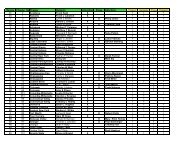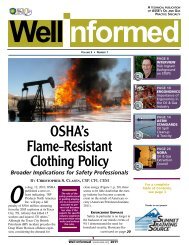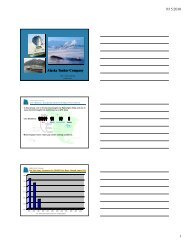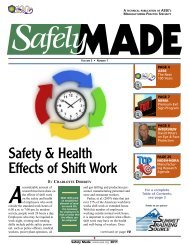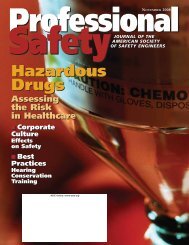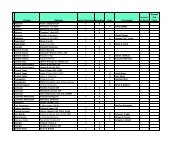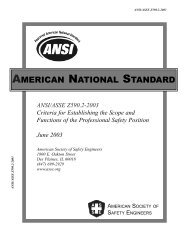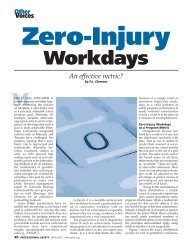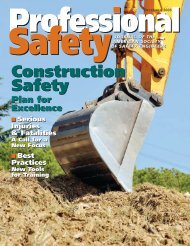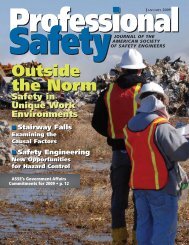Decommissioningrequires an almostmicroscopic attentionto detail. As anorganizationapproaches adecommissioning, itshould assemble aknowledgeableteam with the skillsand expertise neededto plan and executethe projectRegulatory OverlapIn most decommissioning situations, multipleagencies and governmental bodies have jurisdictionover some aspect <strong>of</strong> the closing <strong>of</strong> a single building.Given these <strong>of</strong>ten intentionally redundant regulationsfrom multiple bureaucratic channels, any engineer inthe business will volunteer that it is very easy to misssomething. A simple oversight can be costly to the bot-Regulations to Review<strong>Safety</strong> & Health•Respiratory Protection Part 451 and 29 CFR1919.134 and 1919.103•Noise Part 380 and 29 CFR 1910.95•Hazard Communication Part 92 and 29CFR 1910.1200•Confined Space Entry Part 90 and 29 CFR1910.146•Control <strong>of</strong> Hazardous Energy Part 85 and29 CFR 1910.147•Trenching and Excavation (29 CFR 1926)•Eye Protection (29 CFR 1910.5)•Spills and Releases 29 CFR 1910.12 and 40CFR 311•Fall Protection 29 CFR 1910.66 and 29 CFR1926.500•OSHA Asbestos Regulations (29 CFR1910.1001, general industry, and 1926.1101, constructionindustry)Environmental•Hazardous Waste (40 CFR 260-265)•Land Disposal Restrictions (40 CFR 268)•Clean Air Act•Clean Water Act•Asbestos (40 CFR 61 Subpart M; 40 CFR763 Subpart E)•Underground Storage Tanks (40 CFR 280)20 PROFESSIONAL SAFETY AUGUST <strong>2008</strong> www.asse.orgtom line, but even worse, to alife. Leaving behind hazards topeople, the infrastructure or theenvironment can be both dangerousand expensive.While OSHA and EPA regulationsapply as the minimumstandard for any decommissioningin the U.S., owners alsomust comply with the regulations<strong>of</strong> local jurisdictions andstate-level environmental agencies,many <strong>of</strong> which have morestringent requirements thanfederal OSHA and EPA.For example, in Ohio, someclosings are governed by a statelevelEPA program that iscalled Cessation <strong>of</strong> RegulatedOperations (CRO) (Ohio AdministrativeCode). The programwas created in 1996 to prevent situations such asthat which occurred after a 1987 break-in at a closeddowntire company. Vandals hoping to steal the coppercomponents <strong>of</strong> transformer cores left on site afterthe closing caused the release <strong>of</strong> Askerol, a PCB-containingoil, into a nearby stream. This prompted a 3-year, publicly funded multimilliondollar cleanup.To prevent such mishaps, the CRO programrequires the owner or operator <strong>of</strong> a reporting facilitythat is ceasing regulated operations to do the followingwithin 90 days <strong>of</strong> the cessation:1) Submit the following information to the director<strong>of</strong> OhioEPA: a) the most recent emergency and hazardouschemical inventory form submitted to theState Emergency Response Commission (SERC); b) acurrent OSHA hazardous chemical list or MSDS foreach chemical at the facility required to be on file withthe SERC; and c) a list <strong>of</strong> every stationary tank, vat,electrical transformer and vessel which will remain atthe facility that contains or is contaminated with a regulatedsubstance prior to or at the time <strong>of</strong> cessation;2) Drain and remove all regulated substancesfrom each stationary tank, vat, electrical transformerand vessel and from all piping.3) Lawfully dispose <strong>of</strong>, sell or transfer the regulatedsubstances <strong>of</strong>f site.4) Lawfully transfer <strong>of</strong>f-site all debris, nonstationaryequipment, furnishings, containers, motor vehiclesand rolling stock that contain or are contaminatedwith a regulated substance.5) Certify to the director on a form prescribed thatthe actions required in the previous three items havebeen completed (OhioEPA, 2004).Only after the equipment has been cleaned <strong>of</strong> leaddust, asbestos fibers, oils and chemical lubricants canit be scrapped, sold or transferred <strong>of</strong>f-site. Switches,thermostats, fluorescent bulbs and other devices orcontrols containing mercury or other regulated substancesalso must be removed and recycled, sold ordisposed <strong>of</strong> according to the applicable statutes.Ducts for heating, ventilation and air con-
ditioning—all potential harbors for environmentalsafety hazards—should be cleaned and/or removed.Refrigeration equipment for air conditioningor cooling processes must be removed, and allrefrigeration gases in any machines—transformers,for example—must be recycled or disposed <strong>of</strong> aswell. Underground and aboveground storage tanks<strong>of</strong>ten have entire agencies dedicated to their removaland closure.Financial OptionsAfter a complete capital asset inventory, whichdocuments the value <strong>of</strong> all assets in a facility, adecommissioning contractor <strong>of</strong>ten will work with atax consultant, who can evaluate the tax implications<strong>of</strong> actions such as failing to liquidate inventorythat has not fully depreciated. Fully depreciatedinventory, such as machinery in a tool room, can bea tax deduction. However, if it still has appreciablevalue, a company cannot simply dispose <strong>of</strong> it—andkeeping it can mean a big tax hit.Procedural MattersWhen actual decommissioning begins, the projectmanager must be aware <strong>of</strong> procedural requirementsfor each task. For example, in some jurisdictions,asbestos abatement requires 10 days’ notice to thelocal or state air pollution control agency. Such arequirement cannot be overlooked. The repercussions<strong>of</strong> doing so could be more than fines—someonecould end up in prison because <strong>of</strong> it.“Out <strong>of</strong> sight, out <strong>of</strong> mind” does not apply whenit comes to disposal <strong>of</strong> potentially hazardous chemicals.If a drum <strong>of</strong> solvent or other regulated substanceis discovered some 10 years in the future tohave been disposed <strong>of</strong> at a nonregulated facility,authorities will want to find out exactly whowas—or might have been—responsible and collectdamages. Any business owners which sent materialto the landfill will have to prove that the substancedid not come from their decommissioning projects.In other words, follow all the rules and choose theright landfill. Unlined construction and demolitionlandfills are not good choices.Good Corporate CitizenshipIf a company wants to leave a building, it is recommendedthat it be a “good and responsibleenvironmental citizen” in the interest <strong>of</strong> the environment,workers and the future site owner.One particularly good environmental citizen wasan electric and hybrid gas/electric battery researchand development facility in Michigan. The businessowner, who had been leasing the facility, asked afacility decommissioning contractor to collect andanalyze surface wipe samples from floors and raftersto ensure that the space was clean enough to turnover to the next occupant.Owners have several options to illustrate thisgood citizenship. If redevelopment and reuse arelikely, it is considered the right thing to do to conductPhase I and Phase II ESAs, even taking soilsamples to identify issues that might affect the property’sdesirability. The objective is to identify thepotential for contamination—any <strong>of</strong> which wouldeventually be discovered by potential buyers inassessments required for financial lending.Case Study: The Importance<strong>of</strong> Planning & CooperationIn the case <strong>of</strong> a major automotive componentsmanufacturer in the Midwest, a comprehensivedecommissioning plan developed with guidancefrom qualified consultants not only made a complicated,arduous shutdown process manageable, italso protected workers, nearby residents and theenvironment.Once the company decided to shutter its facility,it acknowledged that various SH&E hazardswould require attention. These issues includedunderground and aboveground storage tanks;asbestos-containing materials; asbestos manufacturingequipment; PCBs; ozone-depleting substances;refrigerants; lead; mercury; batteries; light bulbs;a wastewater treatment plant and its accompanyingsludge and chemicals; a powerhouse; a host <strong>of</strong> manufacturinglines; a spectrum <strong>of</strong> utility systems;and dozens <strong>of</strong> applicable local, state and federalregulations.Shutting the factory’s doors proved to be anythingbut simple. The process does, however, illustratewell the myriad SH&E implications <strong>of</strong> abuilding decommissioning in its common four phases:investigation, design, decontamination/demolitionand closeout.InvestigationDuring the investigation phase, assessing currentfacility conditions is vital in determining the mostcost-effective and efficient manner to exit the property.This investigation focuses primarily on theAreas to Evaluate•asbestos•PCBs•refrigerants•lead•mercury•batteries/lights•manufacturing processes•wastewater treatment plant•powerhouse•noise control•materials containing heavy metals•fugitive dust•erosion control•waste management•fire protection•notifications to regulatory agencies•emergency planning•site-specific safety and health planningwww.asse.org AUGUST <strong>2008</strong> PROFESSIONAL SAFETY 21



